Catocala aholibah
kah-TOCK-uh-lahMa-HOH-li-bah
Strecker, 1874
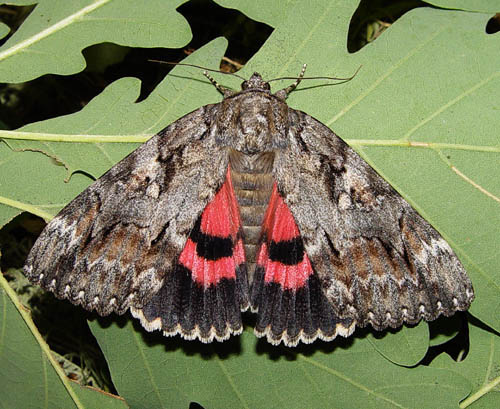
Catocala aholibah
courtesy of Martin Jagelka.
This site has been created by
Bill Oehlke.
Comments, suggestions and/or additional information are welcomed by Bill.
| TAXONOMY:
Superfamily: Noctuoidea
Family: Erebidae, Leach, [1815]
Subfamily: Erebinae, Leach, [1815]
Tribe: Catocalini, Boisduval, [1828]
Genus: Catocala, Schrank, 1802
|
DISTRIBUTION:
Catocala aholibah
(wingspan: 77mm (GM)-80-90mm) flies from
British Columbia south to
California
east to Arizona and north to Colorado.
David Wikle has taken them at Cloverdale Muni Airport, Sonoma County,
California, 24 August 2003.
Canadian records also exist for Saskatchewan (probably in extreme southern Saskatchewan),
so I suspect ???? there are flights in southern Alberta as well.
in addition there are reports from
Nevada,
New Mexico,
North Dakota,
Oregon,
South Dakota,
Texas,
Utah,
Washington and
Wyoming.
protibiae (lat.) laterally without spines
midtibiae spine-like projections present
hindtibiae spine-like projections present
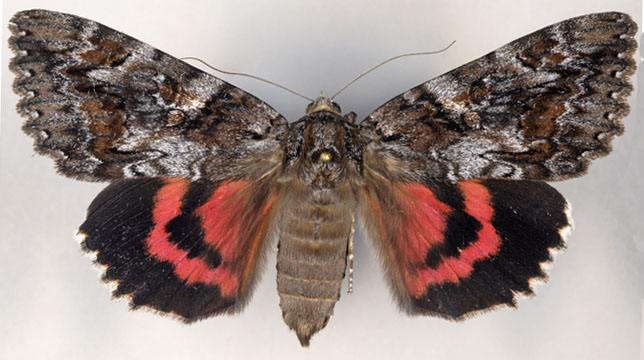
Catocala aholibah, Aromas, San Benito County, California,
August 9, 2012, 77mm, courtesy of Gary McDonald.

Catocala aholibah, Aromas, San Benito County, California,
August 9, 2012, 77mm, courtesy of Gary McDonald.
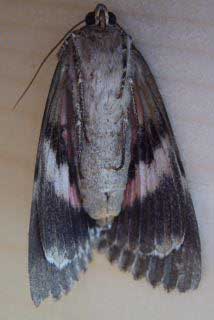
| Aholibah lacks the bar paralleling the forewing inner margin
of allusa. Aholibah also has a diffuse, dark arc running from
the costa along the antemedial line, below the subreniform spot through
the two upper jagged "teeth" of the postmedial line.
The ventral surface of the hindwing shows a light suffusion of pink on the white median band.
Edna Woodward image, Wolf Creek, Josephine County, Oregon, September, 2013. |
|

Catocala aholibah, Lyle-Balch Cemetery,
Klickitat County, Washington,
July, courtesy of John Davis
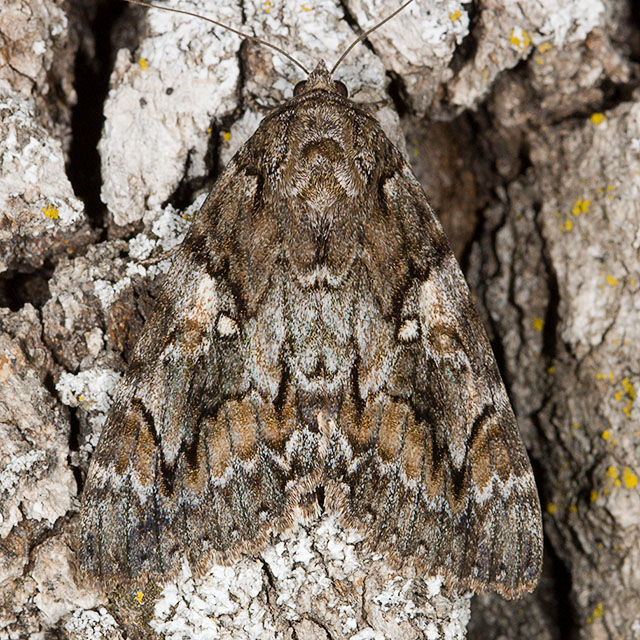
Catocala aholibah Lyle-Balch Cemetery, Klickitat County, Washington,
September, courtesy of John Davis
FLIGHT TIMES AND PREFERRED FOOD PLANTS:
Catocala aholibah are usually on the wing from mid June to early October.
Edna Bottorff sends this image of a Catocala aholibah female, taken October 4, 2009, from Wolf Creek,
Josephine County, southern Oregon.
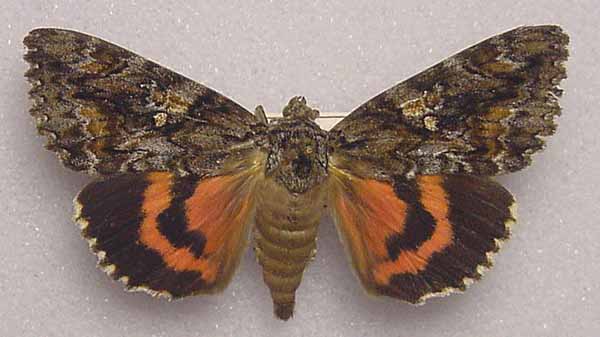
Catocala aholibah male, Rt 155 at Alder Cr Rd, 4900',
Kern Co., CA, June 21, 1992, Kelly Richers, collector, at u.v. light
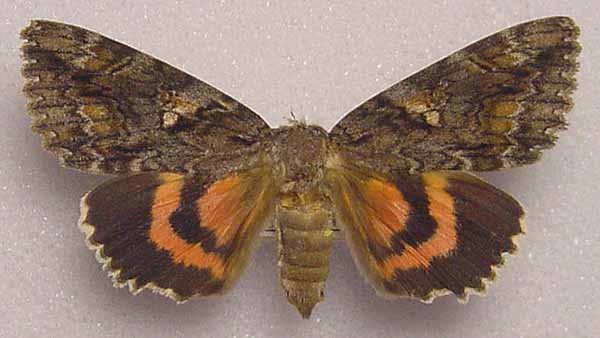
Catocala aholibah female, Rt 155 at Alder Cr Rd, 4900',
Kern Co., CA, June 30, 1992, Kelly Richers, collector, at u.v. light
The Catocala aholibah caterpillar shows a preference for Quercus species: agrifolia, alba, gambelii and garryana.

Catocala aholibah larva courtesy of Martin Jagelka.
ECLOSION:
Adults eclose from pupae at soil surface.
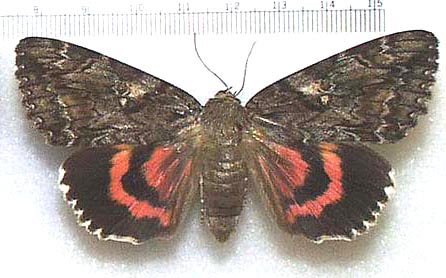
Catocala aholibah courtesy of Bruce Walsh.
SCENTING AND MATING:
Catocala aholibah females emit an airbourne pheromone and males use their antennae to track the scent plume.

Catocala aholibah, Smith Creek, Santa Clara County, California,
July 10, 2008, 1800 feet, courtesy of Owen Holt.
EGGS, CATERPILLARS, COCOONS AND PUPAE:
Eggs are deposited on tree bark in the fall and hatch the following spring.
Mature larvae, commonly found in May and June, are grey with a slight rosy hue. There are single
tubercles on the fifth and eighth abdominal segments.Image courtesy of Jeff Miller from Caterpillars of
Pacific Northwest Forests and Woodlands. |
 |
Camouflage is remarkably well-developed for most of the Catocala species, in the egg, larval and adult stages.
Despite their large size, larvae easily blend in with bark of twigs and stems where they hide during the day.
Jeremy B. Tatum writes, "I once had a full-grown one sitting on a single, unbranched twig, and held it a few inches in front of several
colleagues, who were quite unable to see it. When discovered, however, the caterpillar can jump!" |
 |

Catocala aholibah fifth instar on Gambel's Oak, Karr Canyon, Lincoln National Forest,
Sacramento Mountains, Otero County, New Mexico, May 25, 2009, 7400 feet, courtesy of Bob Barber.
Pupation is usually at or near soil surface under litter or debris. Pupae shortly develop a bluish white "bloom" as shown in the image to the
right courtesy of Jeremy Tatum and Dr. John Snyder. |
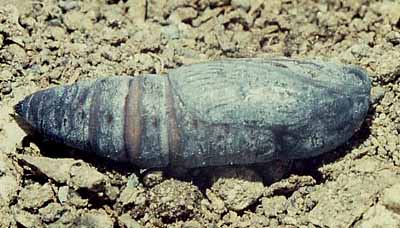 |

Catocala aholibah from Southern Vancouver Island,
courtesy of
Jeremy B. Tatum and Dr. John Snyder.
Larval Food Plants
Listed below are primary food plant(s) and alternate food plants. It is hoped that this alphabetical listing followed by the common
name of the foodplant will prove useful. The list is not exhaustive, although some species seem very host specific.
Experimenting with closely related foodplants is worthwhile.
Quercus agrifolia.....
Quercus alba
Quercus macrocarpa .......
Quercus gambelii
Quercus garryana
|
Live oak
White oak
Bur oak
Gambel oak
Garry oak/Oregon white oak
|
Return to Main Index
This page is brought to you by Bill Oehlke and the
WLSS. Pages are on space rented from Bizland. If you would like to become a "Patron of the Sphingidae/Catocala Sites",
contact Bill.
Please send sightings/images to Bill. I will do my best to respond to requests for identification help.
Enjoy one of nature's wonderments: Live Saturniidae (Giant Silkmoth) cocoons.
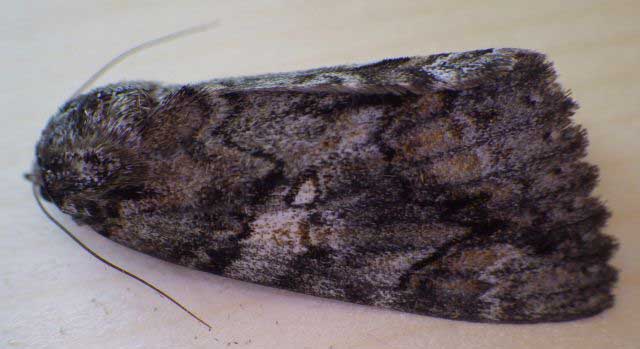
Catocala aholibah, Wolf Creek, Josephine County, Oregon,
September 11, 2013, courtesy of Edna Woodward.

|

To show appreciation for this site, click on the flashing
butterfly to the left, a link
to many worldwide insect sites. |


















